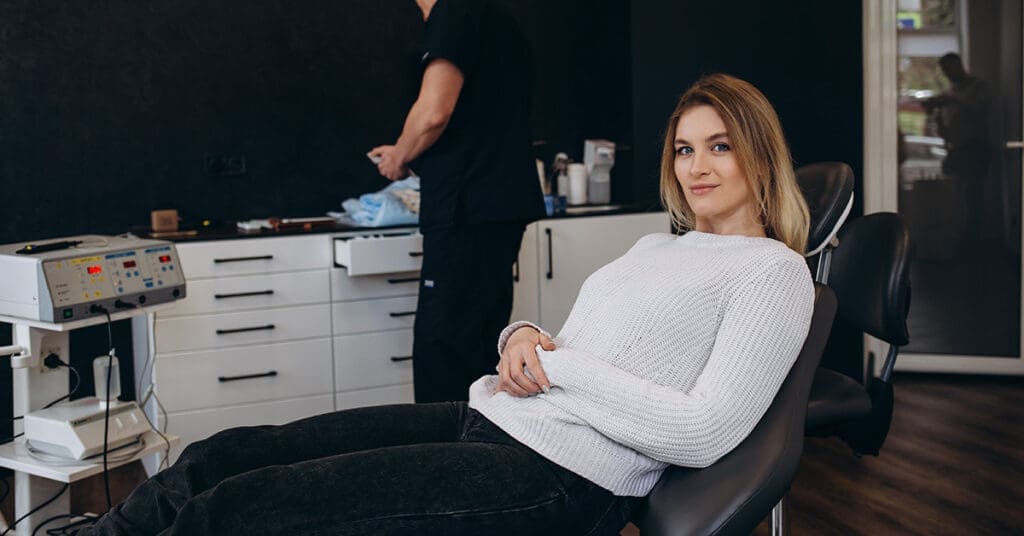Have you ever wondered why some plastic surgeons have a constant stream of patients while others struggle to fill their schedule? A skilled hand alone isn’t enough. Plastic surgery marketing is the bridge that connects you to new patients.
Our guide walks you through marketing strategies to elevate your practice.
From creating a standout online presence to engaging with patients through social media. We’ll cover the tools to grow your brand and build lasting patient relationships.
Let’s get started on transforming your marketing and watching your practice flourish.

Plastic Surgery Marketing Key Takeaways
- Surgical skill alone isn’t enough, marketing connects you to new patients.
- Social media, virtual consultations, and personalized content are now crucial.
- Instagram, Facebook, YouTube, and TikTok are key platforms for showcasing transformations, sharing education, and building community.
- Blogs, videos, and educational posts position you as an authority and answer patient questions.
- Reviews, testimonials, and online reputation management influence patient decisions.
- Your website must be fast, mobile-friendly, visually appealing, easy to navigate, and conversion-focused.
- Use patient-focused language, local keywords, and voice-search optimization to attract patients.
- Google Ads, social media ads, retargeting, and influencer partnerships boost visibility and lead generation.
- Highlight what sets you apart, showcase personality, and maintain a consistent brand across all channels.
- Virtual consultations, AI chatbots, AR previews, personalized marketing, and influencer partnerships are shaping the future.
- Track analytics, stay updated on marketing trends, pivot strategies when needed, and nurture existing patient relationships.
Do Plastic Surgeons Need Marketing?
The question isn’t whether plastic surgeons need marketing.
The question is how much they’re willing to invest in it.
Don’t know how to calculate your marketing budget?
Then use our digital marketing budget calculator on this page.
Let’s face it, word-of-mouth alone is a poor marketing strategy.
Plastic surgery marketing has become a tool for success in this ever-changing field.
In 2023, 24% of adults reported having at least one cosmetic procedure.
This surge in interest means there’s a growing pool of patients out there.
But they’re not going to stumble upon your practice.
That’s where marketing plastic surgery comes into play.
Effective plastic surgeon marketing is about attracting the right patients.
It’s a way to showcase your skills, highlight specialties, and build trust.
This is an industry where trust and reputation are everything.
A solid marketing strategy can be the difference between a flourishing and struggling.
The best plastic surgery marketing plan is when someone searches for “best plastic surgeon near me,” your name pops up.
Moreover, marketing allows you to educate your audience.
Many people are curious about plastic surgery.
Or have questions.
Address concerns and explain procedures through targeted content and social media posts.
This attracts patients and helps build a more informed and confident client base.
Your ability to market skills usefully is what will set you apart in a crowded field.
So, if you’re wondering whether plastic surgeons need marketing, the answer is yes.
How Patient Acquisition is Changing
Back in the day, a simple yellow pages ad or a word-of-mouth referral was enough to keep your practice booming.
Today’s plastic surgery marketing strategies need to be as cutting-edge as the procedures you offer.
One of the most significant shifts we’re seeing is the power of social media marketing.
Social media has been shown to increase procedure volume in plastic surgery clinics.

Nearly two-thirds of people are influenced by social media before and after pictures.
Your Instagram feed could be just as important as your surgical skills.
But, the strategy isn’t just posting pretty pictures.
Patients are researching procedures and reading reviews way before contacting you for a consultation.
This means your digital experience needs to be polished, informative, and engaging everywhere.
Virtual consultations are also becoming increasingly popular.
Another key shift is the rise of personalized marketing.
Thanks to advanced data analytics, plastic surgery practices can now target their marketing efforts with laser precision.
You can tailor your messages to specific demographics or interests at any stage of their journey.
Content marketing is also playing a bigger role than ever.
Patients are hungry for information, and they’re turning to blogs, videos, and podcasts for education.
By creating valuable content, you’ll position yourself as a trusted authority.
Finally, let’s not forget about the importance of reviews and testimonials.
Your reputation is literally at your patients’ fingertips.
Managing positive reviews has become a big part of plastic surgery marketing strategies.
The bottom line?
Patient acquisition in plastic surgery has become digital, personalized, and content-driven.
To stay ahead of the curve, you need to adapt your marketing approach.
Comprehensive Marketing Techniques for Plastic Surgeons
Aesthetic procedures have increased by 41.3% over the past four years,
So, let’s dive into some plastic surgery marketing ideas that’ll help you build a brand.
To start, let’s talk about your unique selling proposition (USP).
What makes you different from every other plastic surgeon out there?
Are you known for your natural-looking results?
Or perhaps you’ve pioneered a groundbreaking technique.
Whatever it is.
Make this the cornerstone of your brand.
This should be in front of all your marketing materials.
Next, your brand should have a cohesive look and feel across all platforms.
This means using the same color scheme, fonts, and imagery style.
But branding is also about storytelling.
Share your journey, your passion, and the impact you’ve had on patients’ lives.
A human touch can be a powerful part of your plastic surgery marketing strategy and help patients make a connection.
Don’t be afraid to showcase your personality, either.
Are you the warm and nurturing type?
Or more of a straight-talking, no-nonsense surgeon?
Let that shine as authenticity is magnetic and patients are drawn to surgeons they can relate to.
Speaking of your audience, get to know them inside and out.
What are their desires, fears, and motivations?
Tailor your brand messaging to speak directly to these points.
Last thing, remember that building a brand is an ongoing process.
Stay open to feedback.
Your brand should be as transformative as the procedures you perform.
Creating a High-Converting Website
Your website is the first impression potential patients have of your practice.
It’s not only a digital brochure; it’s your virtual office, consultation room, and portfolio all rolled into one.
Let’s learn how to create a wellness website that looks great and also converts visitors into patients.

Plastic surgery website design example
Effective Web Design and UX for Plastic Surgeons
When it comes to web design for plastic surgeons, less is often more.
A clean, elegant design that reflects sophistication is the way to go.
Here are six must-have elements:
- Make it easy for visitors to find what they’re looking for. Use intuitive menu structures and clear labels.
- Your website should command attention with high-quality images and clear actions.
- Make it easy for patients to book consultations or contact you.
- Show your credentials, certifications, and awards.
- Real stories from satisfied patients can be persuasive.
- Provide articles about procedures.
Incorporating Before and After Galleries
Before and after galleries are visual proof of your skills and can be incredibly persuasive.
Here’s how to make the most of them:
- Take high-quality images with consistent angles
- Organize photos by procedure type for easy browsing.
- Where possible, include brief patient testimonials alongside the images.
- Consider using sliders or hover effects to showcase the transformation.
- Make sure you have your patient consent.
Optimizing for Speed and Mobile Use
- Aim for load times under 3 seconds. Compress images, use CDNs, and reduce code to speed things up.
- More people access the internet on their phones. Check your site and make sure it looks great and functions well on small screens.
- Your website should automatically adjust to look good on all devices.
- Make sure buttons and links are large enough to be easily tapped on mobile screens. 40 pixels high is a good height for a mobile button.
- Consider a hamburger menu or mobile-friendly navigation options.
Remember, a fast, mobile-friendly wellness website is favored by search engines.
Mastering SEO for Higher Visibility
When it comes to digital marketing for plastic surgeons, local SEO can make your digital experience irresistible.
Using Patient Language and Local Keywords
Think like a patient, not a doctor. That’s the golden rule when it comes to SEO for plastic surgeons.
Here’s how to nail it:
- Use terms patients actually search for. “Nose job” may be searched more than “rhinoplasty”.
- Include your city or region in keywords. “Best plastic surgeon in [Your City]” can work wonders.
- Don’t just focus on broad terms. “Non-surgical facelift options in [Your Area]” can attract ready-to-convert patients.
- Optimize for voice queries like “Where can I get Botox near me?”
- Include phrases like “how to fix droopy eyelids” to catch patients at the research stage.
The goal is to meet potential patients where they are at, using language that resonates with them.
Blogging: Answering Patients’ Questions
Blogging isn’t just sharing your thoughts – it’s a powerful SEO tool. Here’s how to make it work for you:
- Create posts that answer common questions about procedures, recovery, and results. Write around 500-1,000 words per blog.
- Write detailed, informative posts about specific treatments you offer. Write around 1,000-2,000 words per blog.
- Share success stories to provide relatable content. Write around 500-1,000 words per blog and highlight the successful stats.
- Consistent posting tells search engines that your site is active. Post at least once a week.
Use relevant keywords in titles, headers, and throughout the content. Check out our guide on how to write a blog post that breaks the Internet.
Build Backlinks
Backlinks are like digital votes of confidence for your website.
Here’s how to build them:
- Write articles for health and beauty websites then link back to your site.
- Partner with local businesses and earn links from their sites.
- Share newsworthy updates about your practice to earn media coverage.
- Join relevant medical association websites and add your link.
- Videos, infographics and guides are very linkable items that people like to share.
Remember, quality backlinks outperform quantity every day of the week.
A few links from respected sites can be more valuable than dozens from low-quality.
Social Media for the Win
Let’s go over how you can make the most of plastic surgery social media marketing to boost your practice.

How many times to post on each social network from a Neil Patel webinar.
Platform-Specific Strategies: Instagram, Facebook, YouTube
Instagram: The Visual Powerhouse
Instagram had the highest percentage of plastic surgery posts from surgeons.
Personal stories, education, videos, and celebrity involvement are the posts that grab the most eyeballs.
Here’s how to make Instagram work for you:
- Post 1-2 reels and 2-4 stories per day and go live at least once a week
- Share stunning transformations
- Give a peek into your day-to-day life as a surgeon.
- Create short, engaging videos explaining procedures or debunking myths.
- Use this feature for Q&A sessions or polls.
- Use relevant hashtags to increase visibility.
Facebook: The Community Builder
While it might not be as visually-focused, Facebook is great for building a community:
- Post as often as you’d like
- Create a private group for experiences and to ask questions.
- Host regular live streams to answer questions.
- Share written and video testimonials from satisfied clients.
- Post longer-form content explaining procedures in detail.
- Use Facebook Events to promote open houses or special offers.
Facebook’s targeting options for ads are ridiculously powerful.
They allow you to reach potential patients with precision.
YouTube: The Educational Platform
YouTube is perfect for in-depth content that showcases your expertise:
- Post 1 shorts and 1 long-form video per day
- Create detailed videos explaining different surgeries.
- Document a patient’s experience from consultation to recovery.
- Answer common questions in a recurring video series.
- Post example virtual consultations to familiarize patients with the process.
- Partner with other healthcare professionals for expert discussions.
Remember to optimize your video titles, descriptions, and tags for SEO.
Across all platforms, consistency is key in plastic surgery marketing.
Develop a content calendar.
And always engage with your followers by responding to comments and messages.
Paid Advertising Strategies that Work
Let’s review the strategy of plastic surgery ads using Google and social media.
Google Ads & Retargeting Campaigns
Google Ads is the G.O.A.T. in generating immediate leads in the plastic surgery industry.
Here’s how to make the most of Google Ads:
- Focus on specific procedures and local search terms.
- Use these to showcase your phone number, location, and special offers.
- Ensure each landing page is tailored to the ad content.
- Work on improving your Quality Score to lower costs and improve ad positioning.
Retargeting is another powerful tool in your arsenal.
Retargeting is showing visitors already on your site an ad as they navigate through the internet.
Retargeting ads are typically a display or graphical ad.
Create different ad campaigns for various procedures or pages on your site.
Social Media Ads
- Facebook and Instagram Ads. Use targeting to reach people interested in beauty, self-improvement, and procedures. Create lookalike audiences based on your current patient list to find similar patients.
Use carousel ads to showcase before and after photos or different procedures. - LinkedIn Ads. Great for targeting professionals who might be interested in subtle enhancements. Use sponsored content to share educational articles about your procedures.
- TikTok Ads. Perfect for reaching a younger demographic interested in non-invasive procedures. Create engaging, short-form video content that educates and entertains.
Across all platforms, consider these strategies:
- Video Ads: Show brief procedure walkthroughs or testimonials.
- Influencer Partnerships: Collaborate with local influencers for authentic promotion.
- Special Offers: Run limited-time promotions to create urgency.
- Remarketing: Use platform-specific remarketing tools to re-engage interested users.
Remember, the goal in plastic surgery advertisements is to balance professionalism with approachability.
Your ads should send expertise vibes and make viewers feel comfortable in choosing your practice.
Reputation Management and Reviews
Reputation management is the invisible hand that guides patients to your practice or sends them to your competitors.
How can you build and maintain a stellar online reputation?
Building Your Online Reputation with Patient Reviews
Patient reviews are digital word-of-mouths.
Here’s how to cultivate a collection of glowing testimonials:
- Set up profiles on review sites like Google Business Profile, Yelp, and REALSELF.
- Ask for reviews when patients are happiest, usually after seeing amazing results.
- Give patients a simple guide on how to leave a review.
- Show that you value patient feedback. Respond to every review, positive or negative.
- Feature the best reviews on your website and social media platforms.
- Encourage satisfied patients to share their experiences on camera.
Pro Tip:
Authenticity is key.
Genuine reviews from real patients are always more powerful than any marketing copy.
The Future of Plastic Surgery Marketing
As we look ahead, the landscape of plastic surgery marketing is evolving at a breakneck pace.
The Plastic Surgeons market in the US is estimated to be $86 billion at the end of 2025.
This growth indicates a thriving industry, and also increases competition.
To stay ahead of the curve, plastic surgeons need to embrace marketing strategies that resonate with the modern patient.
Virtual Consultations
The pandemic accelerated the adoption of virtual consultations, and people love them.
Here’s how to make the most of them:
- Invest in a reliable, easy-to-use telehealth platform.
- Send patients guides on how to prepare for a virtual consultation.
- Use advanced imaging software to show potential results during the consultation.
- Perform a robust follow-up system to nurture leads after the consultation.
- Offer both virtual and in-person consultations to cater to different patient preferences.
- Virtual consultations provide convenience for patients and allow you to expand your geographical reach.
Looking ahead, we can expect to see more innovative techniques emerge:
- AI-Powered Chatbots
- Augmented Reality (AR) Results
- Personalized Marketing Automation
- Voice Search Optimization
- Influencer Partnerships
9 Concluding Takeaways
As we wrap up this article on plastic surgery marketing, it’s clear that success in this field requires more than surgical skill.
It demands an understanding of marketing, technologies, and a commitment to patient satisfaction.
Here are 9 takeaways to keep in mind as you refine your marketing strategy:
- Make it a habit to educate yourself on the latest marketing trends and technologies.
- Pay attention to their comments, questions, and concerns. Use this information to improve your services and marketing approach.
- Use analytics tools to guide your decisions on where to invest your time and resources.
- Authenticity builds trust, and trust builds a loyal patient base.
- Invest in their training and ensure they’re aligned with your practice’s vision and values.
- While it’s exciting to try new techniques, don’t completely abandon successful marketing strategies.
- Continue to focus on educational content that helps potential patients make informed decisions.
- Be prepared to pivot your marketing strategy when necessary.
- Don’t forget about nurturing relationships with your existing patients.
Keep learning and focusing on what matters most, helping your patients feel their best.
Their satisfaction is the measure of your success in the operating room and in marketing efforts.
Plastic Surgery Marketing FAQs
What are the most effective marketing strategies for plastic surgery practices in the United States?
The most effective marketing strategies for plastic surgery practices in the U.S. are local SEO, paid ads, social media marketing and content creation.
Start with local SEO to appear in Google Maps and “near me” searches by optimizing your website and Google Business Profile.
Use paid ads on Google or social media to target patients searching for specific procedures. Create educational content; blogs, videos, and before-and-after galleries that showcase expertise.
Stay active on social media to engage with potential patients. Finally, encourage satisfied patients to leave reviews.
What are the best ways to use social media for plastic surgery marketing?
The best ways to use social media for plastic surgery marketing are by sharing visuals, educational content, patient testimonials, and engaging with followers.
Post before-and-after photos, with permission, to show results and build trust. Use short videos or Reels to explain procedures, recovery timelines, or common myths, these perform especially well on Instagram and TikTok.
Try AI video testimonials and turn text reviews into engaging social videos. Share patient success stories and highlight real outcomes. Stay consistent with posting and responding to comments to build relationships and encourage inquiries.




